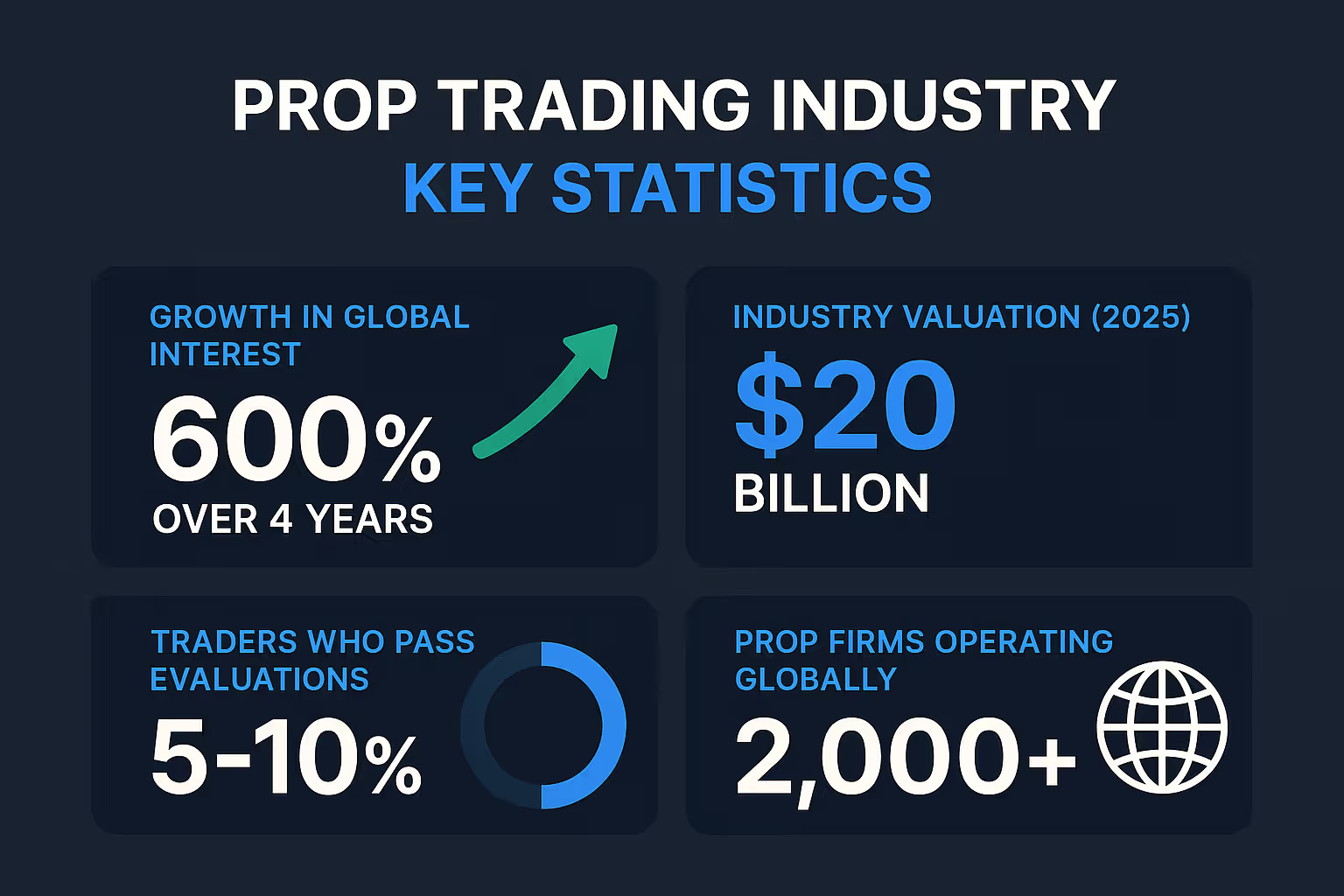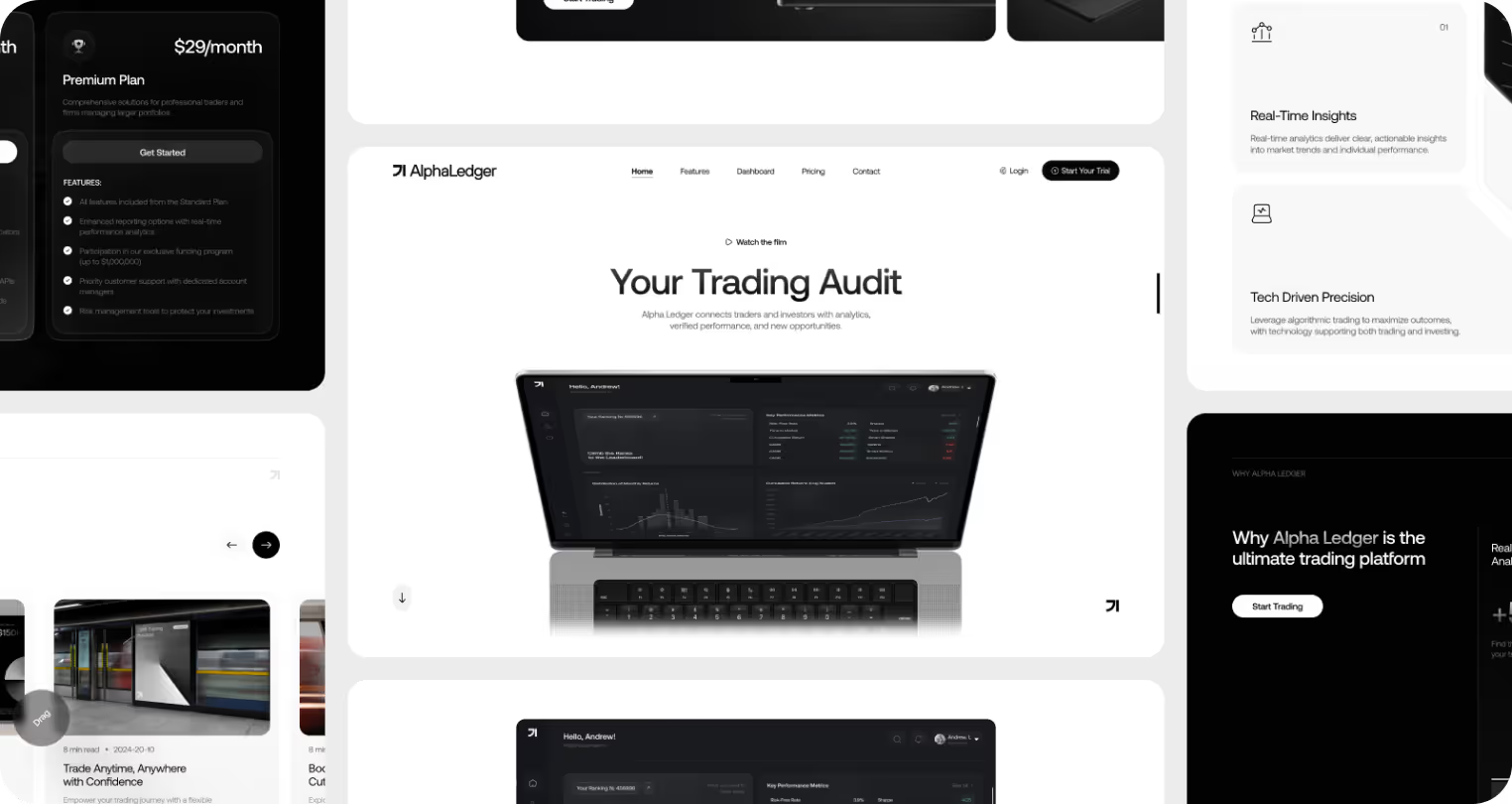Prop Trading Industry: How to Tell If a Firm Is Legit Through Subtle Cues

Introduction
The promise sounds almost too good to be true: trade with someone else’s capital, keep up to 90% of the profits, and build a career without risking your own money. For many traders, prop firms sound like the dream — the shortcut to financial freedom.
But for every success story, there’s a cautionary tale: vanished payouts, fake dashboards, fine print designed to fail you. And that’s not coincidence. The prop trading industry has exploded — growing more than 600% in the past four years and surpassing a $20 billion valuation in 2025 — attracting not only ambitious traders, but also opportunists who saw a gold rush in people’s trust.
Scammers have evolved, too. Today’s fake prop firms look convincing: sleek websites, “instant funding” offers, and testimonials that sound real. Some even copy legitimate platforms pixel for pixel. For traders chasing the dream, it’s easy to miss the subtle signs — until it’s too late.
So, are prop trading firms legit?
The answer isn’t black and white. Some are genuinely building opportunities for traders worldwide. Others? Elaborate traps. Knowing how to tell one from the other — through their structure, design, and communication — is the skill that separates the lucky from the prepared.
This guide breaks it down. You’ll learn how the prop trading world actually works, what red flags to spot before you ever pay a “challenge fee,” and why even the smallest details in a firm’s presentation can reveal a lot about its integrity.
Because as a creative agency that has worked with multiple fintech and trading brands, we’ve seen how authentic companies build trust — and how the fake ones try to imitate it.
What Is Prop Trading?
Proprietary trading — or simply prop trading — is a model where traders use a firm’s capital instead of their own, sharing a portion of the profits in return. It’s a system built on performance, giving skilled traders access to real funding without risking personal savings.
Here’s how it typically works:
- Evaluation Phase:
You start by paying a one-time fee (usually between $100–$500) to enter a trading challenge — a test of your strategy, discipline, and risk management. - Funding Phase:
Pass the evaluation, and the firm entrusts you with a funded account — often anywhere from $10,000 to $2 million — to trade real capital under their conditions. - Profit Sharing:
When you win, you win big. Most firms offer traders 70–90% of the profits while keeping a small cut for providing the capital and infrastructure. - Scaling Up:
Consistent performance often unlocks growth — higher capital limits, larger profit potential, and, for some, a full-time trading partnership.
In theory, it’s a win-win: skilled traders get access to capital they could never deploy on their own, and firms gain a network of high-performing traders without the cost of hiring them.
The Rise of Prop Trading
The numbers tell a powerful story — not just of growth, but of pressing tension between opportunity and risk. Over four years, interest in prop trading has risen by 600%, while the industry’s estimated value nears $20 billion. Yet behind that expansion, only 5–10% of traders ever pass the evaluation hurdles. Across the world, more than 2,000 prop firms now compete for attention in crowded markets.

What’s driving this explosion?
- Democratized access: what used to require deep capital is now available for a few hundred dollars.
- Low barrier to entry: firms emerge with minimal overhead, fueled by tech and modular infrastructure.
- Social momentum: viral success stories and community hype propel more people into the space.
- Pandemic shift: remote work and digital income streams pushed many to explore trading as an alternative.
But rapid expansion also attracted bad actors. As the industry’s footprint grew, so did the sophistication of scams — making sharp design and clear messaging more important than ever.
Are Prop Firms Legit or Scam?
So far, based on everything we’ve covered, it’s clear there’s no simple yes-or-no answer to whether a prop trading firm is legit or a scam.
Some firms genuinely provide skilled traders with opportunities to grow and succeed, while others rely on inflated promises, fake testimonials, or unclear terms to take advantage of inexperience.
Here’s what distinguishes them:
Legitimate Prop Trading Companies
Legit prop firms don’t appear overnight — they earn credibility through transparency, robust systems, and a verifiable track record. These are the companies where skilled traders can realistically grow, backed by fair evaluation processes and professional infrastructure.
Key Features
- Transparent Operations: Clear business registration, accessible leadership, and policies that can be independently verified.
- Realistic Promises: Honest communication about the difficulty of trading and typical success rates — no “guaranteed profits” claims.
- Proven Track Record: Years of consistent operations with documented payouts that traders can trust.
- Professional Infrastructure: Trading platforms, technology systems, and risk management designed to function reliably in real-world conditions.
- Regulatory Compliance: Properly registered and operating within the applicable legal frameworks.
- Community Presence: Authentic reviews, active social media engagement, and real trader testimonials.
- Fair Evaluation Process: Challenges and tests that genuinely assess skill rather than luck or random chance.
- Consistent Branding: Cohesive visual identity and professional communication across websites, platforms, and all touchpoints.
Examples of established firms: FTMO, TopStep, The Funded Trader, Apex Trader Funding — all recognized for verified payouts and solid reputations in the trading community.

Vantir – a proprietary trading platform, provided our studio with the perfect opportunity to demonstrate how design and branding can reinforce legitimacy. We translated their operational clarity into a cohesive brand and intuitive UX, applying the same principles that define trustworthy firms.
By reflecting their operational transparency in the design and interface, we helped make the platform easier to understand and navigate, supporting traders in making informed decisions.
See the live website → Vantir
Scam Proprietary Trading Companies
Scam operations are sophisticated and often look convincing at first glance. They rely on psychology, marketing, and incomplete information to lure traders in.
Key Red Flags
- Unrealistic Claims: Promises of guaranteed profits or “easy money.”
- Inflated or Misleading Statistics: Numbers that don’t match the firm’s operational history.
- Weak Online Presence: Few authentic reviews despite claims of thousands of traders.
- Copied or Stolen Content: Marketing materials or websites replicated from legitimate firms.
- Fake Testimonials: Polished, repeated, or unverifiable trader stories.
- Vague Terms & Conditions: Rules that change frequently or are hard to interpret.
- No Verifiable Registration: Missing or fabricated business credentials.
- Pressure Tactics: Limited-time offers designed to rush decisions.
- Dummy Accounts: Pre-loaded “winning trades” or inflated performance pushed to influencers.
Scams often collapse under scrutiny, but the best defense is systematic evaluation — understanding what signals legitimacy and what signals risk.
How to Tell If a Prop Firm Is Legit
Due diligence is your first defense in the prop trading world. The difference between a firm that empowers traders and one that exploits them is often in the details — the subtle signals that reveal whether a company is built to last or just to take advantage:
Regulatory and Legal Signals
Legitimate firms don’t hide behind vague claims or empty websites. Look for:
- Business Registration – A credible firm lists its registration clearly and can be independently verified. For example, FTMO’s Czech incorporation is public and transparent.
- Leadership Transparency – Founders and executives should be visible, with verifiable professional backgrounds. Firms that obscure leadership are often hiding risk.
- Regulatory Compliance – Even if prop firms aren’t fully regulated like brokers, they still operate under local business laws. Missing or unverifiable compliance signals caution.
Financial Transparency
Numbers tell the story, if you know how to read them:
- Realistic Payouts – Firms promising instant, massive profits are usually overpromising. Established companies like TopStep show steady growth over years, not overnight riches.
- Clear Fees – All costs — evaluation fees, monthly subscriptions, profit splits — should be upfront. Hidden fees are a warning sign.
- Documented Payout Process – Legit firms outline the procedure and realistic processing times. Instant payouts for large sums rarely exist.
- Trading Conditions – Specifics like spreads, commissions, and trading hours reveal a lot. Clear terms signal structure and professionalism, vague ones signal risk.
Community and Social Proof
A firm’s credibility is also built in its community footprint:
- Reviews – Authentic feedback accumulates naturally over time. Be skeptical of clusters of overly positive reviews.
- Social Media Presence – Engagement over vanity metrics. Meaningful conversations with real traders matter more than follower counts.
- Trader Testimonials – Verified, consistent stories across platforms indicate authenticity. Polished, identical testimonials are a red flag.
- Industry Recognition – Appearances in trading publications, webinars, or partnerships signal that peers respect the firm.
Digital Presence and User Experience
In trading, every digital touchpoint tells a story. From the website to the platform interface, clarity, consistency, and design speak volumes about a firm’s reliability.

- UX Communication – Legitimate firms explain complex rules in clear language, set realistic expectations, respond quickly, and offer educational resources.
- Visual Consistency – Cohesive design across website, social media, and platforms signals attention to detail and long-term perspective. Inconsistent branding often reveals a lack of investment in infrastructure.
- Professional Web Design – Original content, fast loading, mobile optimization, HTTPS security, and intuitive navigation all indicate legitimacy. Copying content or poor performance often reflects inexperience or intent to mislead.
Frequently Asked Questions
How can I verify if a prop trading firm is legitimate?
Start by checking their business registration through government databases in their claimed jurisdiction. Look for consistent reviews across multiple platforms, verify their leadership team, and confirm their payout claims align with their operational timeline. Legitimate firms are transparent about their operations and don't hide basic business information.
What percentage of traders actually succeed with prop firms?
Industry data shows only 5-10% of traders pass initial evaluations, and just 1-2% maintain long-term funding. About 7% of funded traders ever receive payouts. These low success rates are why legitimate firms are honest about difficulty while scams promise easy success.
Why do some prop firms copy content from other companies?
Content copying is typically a sign of scam operations that lack resources or intention to build legitimate businesses. They copy successful firms' websites and marketing materials to appear established while focusing on quick fee collection rather than actual trader funding.
How important is branding when evaluating prop firms?
Professional branding indicates serious business investment and long-term thinking. Legitimate firms invest in consistent, original branding because they plan to build lasting relationships with traders. Poor or copied branding often signals rushed operations or scam intentions.
What is the 2% rule in prop firms?
The 2% rule means you never risk more than 2% of your account equity on any single trade. For example, with a $50,000 account, you could risk up to $1,000 per trade. This risk management rule is standard across most legitimate prop firms to protect both trader and firm capital.
Wrapping Up
Are prop trading firms legit? The answer is nuanced: many are legitimate, but many others are sophisticated scams.
The legitimate firms – FTMO, TopStep, Apex Trader Funding, and others – have built sustainable businesses by fairly evaluating traders and sharing profits with successful performers. Others rely on fake testimonials, copied websites, and empty promises to collect fees.
Your best protection is careful due diligence:
- Verify business registration and regulatory compliance
- Check review authenticity across multiple platforms
- Analyze their claims against industry statistics
- Evaluate their branding and communication for professionalism
- Start small and test their processes before committing significant funds
If it sounds too good to be true, it probably is. Legitimate firms are honest about challenges because they want long-term success, not quick fees.
Take time to research, verify claims, and trust your instincts. Your trading career depends on it!











